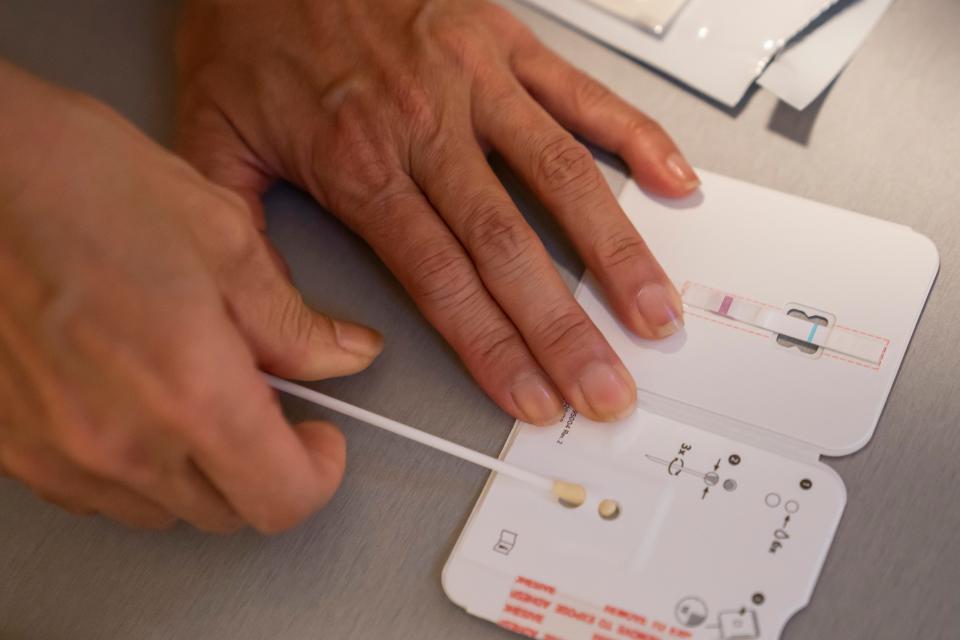Should you be worried about latest COVID variant? Will the new vaccines fight BA.2.86?
The newest COVID-19 variant isn't as scary as it seemed at first, and fall booster shots should protect against it and other variants circulating now, new data suggests.
In a clinical trial, the updated vaccine generated a nearly ninefold increase in neutralizing antibodies against the BA.2.86 variant, according to data released early Tuesday from vaccine maker Moderna. Although extremely rare in the United States, the new variant has a number of mutations in the spike protein targeted by vaccines, which made experts worry that shots and previous infections wouldn't be protective.
But three studies released since the weekend, along with Moderna's new data, suggest the variant, nicknamed Pirola, isn't so bad − at least for now, said Dr. Eric Topol, professor and executive vice president of Scripps Research in La Jolla, California.
"It's been downgraded from a hurricane to not even a tropical storm. We're lucky," Topol said. "This one could have been really bad."

State of the pandemic
COVID-19 infections have been rising since early July, data from the Centers for Disease Control and Prevention shows. Hospitalizations are up nearly 16% and deaths nearly 17% in the week that ended Thursday compared with the week before, though totals remain well below previous peaks.
"It's not looking so good from the standpoint of infections," Topol said.
According to CDC data, EG.5, sometimes called Eris, accounts for more than 21% of COVID-19 infections in the United States; FL.1.5.1 for more than 14%; and two XB.1.16 variants a total of 18%. A wide variety of variants make up the balance.
The wave is probably being driven by fading protection against the virus and the lack of prevention measures like masking and social distancing, Topol said. Officials are urging people to get boosters this fall, particularly if they are over 65 or have underlying health conditions.
Current vaccines do not provide long-lasting protection against infection with COVID-19, but young, otherwise healthy people have generally been protected against severe disease from either vaccination or previous infection. Vaccines have been shown to reduce the risk of long COVID-19, in which people have lingering symptoms such as brain fog and crushing fatigue for months or even years after an infection.
Everyone can benefit from a vaccine, Topol said, but the size of the benefit is much greater for those who are older or have health problems.
"Immunity to this virus after six months is not very good for high-risk people," he said.

Where the vaccines stand
In June, a Food and Drug Administration advisory panel recommended that this fall's booster target the XBB.1.5 variant.
Panel members said they didn't expect the variant, which dominated infections this spring, would still be in full force this fall. But they had hoped XBB.1.5 would be close enough to whichever variant took over that the vaccine would be protective.
So far, that gamble looks as if it's paying off.
Pfizer's laboratory research shows its updated vaccine also effectively prevents severe disease from variants XBB.1.16., XBB.2.3 and EG.5.1.
Pfizer-BioNTech's and Moderna's vaccines, which are based on messenger RNA technology, are expected to become available in the U.S. almost immediately after a CDC advisory committee meeting Sept. 12 that will recommend how the boosters should be used.
Novavax's vaccine, which uses tiny particles along with an adjuvant to amplify its effects, is also expected to become available as soon as meets the federal requirements.
The European Commission authorized Pfizer-BioNTech's vaccine September 1, and the companies have already begun delivery.

What we know about BA.2.86
Pirola, officially called BA.2.86, has been spotted only a few times in the United States, but it has already made the World Health Organization's list of "variants of concern."
One of more than 1,500 known variants of Omicron, BA.2.86, has 34 to 36 different mutations in the spike protein compared with XBB.1.5. As of late last week, Texas was the fourth state to report a case of BA.2.86, according to Houston Methodist Hospital, and it had been identified in other countries, including Israel, Denmark and South Africa.
But three new studies out this week suggest BA.2.86 is not as infectious as earlier variants or likely to undermine vaccines and established immunity. The first, posted online and not yet peer-reviewed, showed that the variant does not penetrate cells very well, suggesting it will not cause a tremendous number of infections.
A second study, also in preprint, shows that the variant does not evade the immune system as much as had been feared. People in Sweden who had been exposed to XBB.1.5 seemed to have good protection against BA.2.86.
A third, again not yet peer-reviewed, showed that despite all its mutations, BA.2.86 does not seem to be good at avoiding immune protections. The Moderna data, though lacking the context of how the ninefold increase in antibodies compares with other variants, also indicates the vaccine will remain effective.
The combination of all these new data points suggests BA.2.86 won't be a major threat as it stands now, Topol said. But he and others worry it could add mutations over time, becoming more contagious and more likely to avoid immunity protections and vaccines.
"In the months ahead, it could be that BA.2.86 picks up some more mutations and behaves differently," he said. "But right now, things are looking pretty good from the standpoint of the booster."
Contact Karen Weintraub at kweintraub@usatoday.com.
Health and patient safety coverage at USA TODAY is made possible in part by a grant from the Masimo Foundation for Ethics, Innovation and Competition in Healthcare. The Masimo Foundation does not provide editorial input.

This article originally appeared on USA TODAY: Worried about new COVID variant? What the data shows about BA.2.86.

